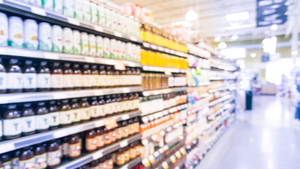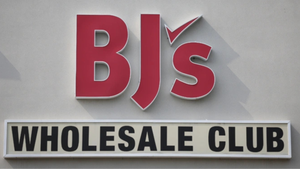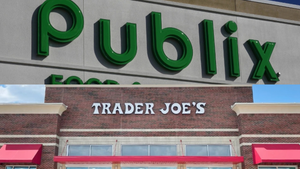Why retailers should care about functional beveragesWhy retailers should care about functional beverages
The popularity of the nutrient-rich products just continues to grow
March 26, 2024

It is becoming a “battle of the fittest” in the beverage aisles of grocery retailers, as new functional beverages vie for shelf space with both traditional carbonated soft drinks and other drinks offering hydration and refreshment.
Retailers are rethinking their merchandising to make room for more functional beverages in their assortments, as consumers seek more drinks with added benefits to incorporate into their everyday diets, driving double-digit sales gains for many of these products.
“Bottled water, seltzer — and in some of our stores, alcohol — were all products that regularly claimed prime merchandising space,” said Amy Brophy, a spokeswoman for Natural Grocers by Vitamin Cottage. “Functional beverages have now politely elbowed their way in.”
Many of the retailer’s stores have expanded their functional beverage assortments in grab-and-go areas, she said.
“We don’t want people to have to search for these,” Brophy said.
Christina Schmidt, category manager, shelf-stable beverages, KeHE Distributors, said retailers are taking a variety of approaches to merchandising functional beverages, including placing them within the base category, such as water or ready-to-drink tea and coffee. Others are carving out sections within the beverage aisle, and using cooler space for both refrigerated and ambient functional beverages.
Some retailers are also creating case-stack displays for secondary exposure, or utilizing endcaps during peak seasons to drive sales of ambient products, she said.
At FreshDirect, the functional beverage assortment has doubled over the past few years, said Juliana Bilodeau, associate category manager, snacks and non-alcoholic beverages at the online retailer. Functional beverages are growing faster than every other subcategory in beverages, she said, noting that the fastest-growing products recently have been coconut water, energy drinks, and functional sodas.
“We are also seeing success in stock-up sales, where customers can try multiple different flavors at a discounted price that they might not have done at full price,” she said.
Consumers seek concrete benefits
Consumers’ longstanding interest in functional beverages got a boost from the increased focus on nutrition during the pandemic, said Roger Dilworth, senior analyst, Beverage Marketing Corp.
“That being said, consumer-need states such as refreshment and hydration continue to dominate, with the perceived need for functionality still evolving,” he said.
Among the best-performing subcategories within functional beverages are protein drinks and meal replacement drinks, “performance” energy drinks, and gut-health drinks, Dilworth said.
“The unifying theme seems to be a concrete benefit perceived by the consumer as opposed to a vague benefit such as being ‘rich in antioxidants,’” he said.
The functional beverage market in North America is expected to increase to about $70.8 billion by 2028, compared with $50.7 billion in 2023, according to research from beverage ingredient supplier American International Foods, for a compound annual growth rate of 6.9%.
Reducing sugar intake
One of the driving forces in the functional beverage category is consumers’ desire to reduce their sugar intake, said Brophy. In fact, she said Natural Grocers has many customers who visit its stores “almost daily” seeking functional beverages with no or reduced sugar.
“You can hydrate with something that’s good for you, and often less expensive than stopping for coffee,” she said. “Check out our stores during the lunch rush, and you’re likely to even catch a wave of high school students reaching for these drinks, the way some of us used to reach for a Slurpee at a gas station.”
In addition to seeking to reduce their sugar intake, consumers are also attracted to beverages that feature clean labels and more natural ingredients, Brophy said.
“Brands are getting more creative with their ingredients and packaging,” she said. “Customers want transparency, now more than ever.”
Bilodeau of FreshDirect agreed that more brands are highlighting attributes such as “natural,” “free of additives,” “clean,” and others.
“I have seen more brands using prebiotics, probiotics, natural flavors, adaptogens, vitamins, minerals, and [other ingredients] to display the health benefits of their beverages and encourage trial,” she said. “I am also seeing carbonated beverage and water brands that have been around for a long time reformulating and trying to stay relevant in the space.”
Dilworth said there has been some positive impact from clean labels and natural ingredients, particularly herbs such as ginger, turmeric, and ashwagandha, although he added that clean labels and natural ingredients are not essential for functional beverage sales and innovation.
Another trend in the category has been the emergence of more functional waters. In addition to vitamin waters, alkaline waters have emerged in recent years, as well as protein-infused waters, Dilworth said.
“Some of these have slowed of late, as functional ingredients are sometimes difficult to mask,” he said.
Dilworth predicted that the broadly defined category of functional beverages should grow dollar sales in the low- to mid-single-digits.
“They should continue to gain share from ‘non-functional’ beverages, but not to as great a degree as some might hope, given that the impulse towards refreshment remains strong with the consumer,” he said
About the Author
You May Also Like






